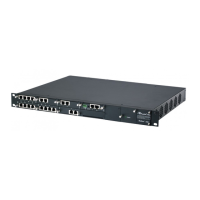Version 7.2 791 Mediant 500L Gateway & E-SBC
User's Manual 45. Auxiliary Files
45 Auxiliary Files
You can load the following Auxiliary files to the device.
Table 45-1: Auxiliary Files
File Description
INI Configures the device. The Web interface enables practically full device
provisioning. However, some features may only be configured by ini file or you
may wish to configure your device through ini file. For more information, see ''INI
File-Based Management'' on page 105.
Call Progress
Tones
Region-specific, telephone exchange-dependent file that contains the Call
Progress Tones (CPT) levels and frequencies for the device. The default CPT
file is U.S.A. For more information, see ''Call Progress Tones File'' on page 793.
Prerecorded
Tones
The Prerecorded Tones (PRT) file enhances the device's capabilities of playing
a wide range of telephone exchange tones that cannot be defined in the CPT
file. For more information, see ''Prerecorded Tones File'' on page 798.
Dial Plan Provides dialing plans, for example, to know when to stop collecting dialed digits
and start forwarding them or for obtaining the destination IP address for
outbound IP routing. For more information, see ''Dial Plan File'' on page 799.
User Info The User Information file maps PBX extensions to IP numbers. The file can be
used to represent PBX extensions as IP phones in the global 'IP world'. For
more information, see ''User Information File'' on page 807.
AMD Sensitivity Answer Machine Detector (AMD) Sensitivity file containing the AMD Sensitivity
suites. For more information, see AMD Sensitivity File on page 816.
SBC Wizard
Template Package
Contains the vendor-interoperability configuration templates for the SBC
Configuration Wizard. For more information, see SBC Configuration Wizard on
page 851).
45.1 Loading Auxiliary Files
You can load Auxiliary files to the device using one of the following methods:
Web interface - see ''Loading Auxiliary Files through Web Interface'' on page 792
CLI - see Loading Auxiliary Files through CLI on page 793
TFTP - see Loading Auxiliary Files through ini File using TFTP
One Voice Operations Center (OVOC) – refer to the OVOC User’s Manual
Note:
• You can automatically load Auxiliary files from a remote server using the device's
Automatic Update mechanism (see Automatic Update Mechanism).
• Saving Auxiliary files to flash memory may disrupt traffic on the device. To avoid
this, disable all traffic on the device by performing a graceful lock as described in
''Locking and Unlocking the Device'' on page 781.

